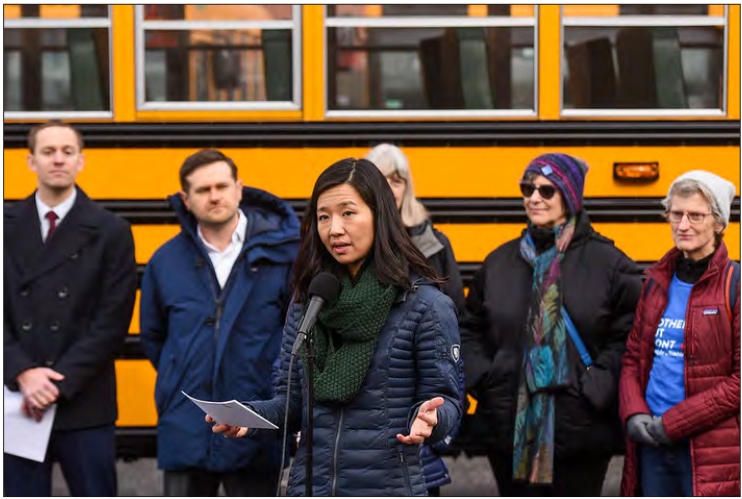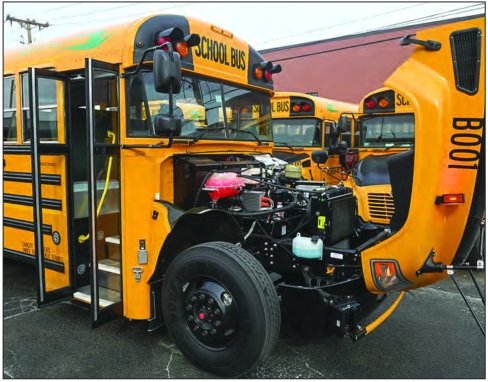
Using
new federal funding aimed at reducing diesel emissions, the city is now
looking to buy 10 new electric buses and retrofit 15 existing diesel
buses to run on electric batteries instead, a step Boston Public
School’s transportation department said will be important to meet the
2030 goal of electrifying the whole fleet.

The hood of an
electric school bus sits open during an event unveiling the city’s first
20 electric school buses in February 2023.
As Boston Public Schools looks to electrify its fleet of school buses it’s setting its sights on a new horizon: transforming existing diesel-powered and other internal combustion engine buses into electric ones.
It’s an effort that is being supported by a new $2 million grant from the federal Environmental Protection Agency, announced Oct. 18 to retrofit, or “repower” 15 buses in the fleet.
“We don’t just want to avoid being wasteful by reducing emissions, we want to avoid being wasteful in a full picture of that,” said Jackie Hayes, BPS deputy director of transportation. “We don’t want to waste all of the good parts of the bus that we could be using. We don’t want to waste funding buying new when we have great existing things in our own fleet that we could be getting more life out of.”
The retrofitting funding comes alongside another $2 million from the EPA to the city dedicated to buying new electric school buses. The two grants are both part of a total of $125 million in federal investments nationwide to reduce diesel emissions.
In New England and other parts of the country, that funding is also going to replacing or retrofitting school buses, as well as addressing diesel emissions in other areas like freight or port infrastructure. For example, through about $1.6 million the Columbia-Willamette Clean Cities Coalition will replace diesel-powered equipment at a port in Everett.
“Through the selection of the city of Boston and the Columbia Willamette Clean Cities Coalition, we
will see cost-effective emission reductions which will improve air
quality and protect the health of our children, nearby communities, and
port workers,” said EPA New England Regional Administrator David W. Cash
in a statement.
Those
15 retrofitted buses, as well as the 10 that will be bought new, will
help address environmental and health concerns in the city, said Hessann
Farooqi, executive director of the Boston Climate Action Network.
“It’s a great thing when we can get people around without having to pollute our air and to make our health worse,” Farooqi said.
Beyond
their environmental impacts, diesel emissions can lead to conditions
like asthma and other respiratory illnesses as well as worsen things
like heart and lung disease. Impacts can be worse for children who have
smaller lungs and take more breaths per minute.
Already, Boston residents
face worse rates of asthma compared to the rest of the state. According
to a report from the Boston Public Health Commission, in 2021, 13.1% of
Boston adults reported having asthma. By comparison, 11.7% of adults
across the state reported having asthma.
Among
both adults and Boston Public School students, Black and Latinx
residents in the city reported worse asthma rates compared to their
white counterparts.
As
a general concept, replacing the engine of a school bus before its
outer shell is nothing new, Hayes said. Often the outside of the bus,
which has to meet rigorous crash test standards, outlasts the pieces
that keep it moving, so rebuilding or replacing an engine is common.
But,
while repowering buses to electrify them isn’t brand new, Hayes said it
has largely been done as proof of concept. Through the funding targeted
at retrofitting the buses — the $2 million from the EPA will
be matched by about $1.6 million from the city of Boston — the district
is aiming to figure out how to make repowering a practical way of
shifting the composition of its fleet.
“We
want to really look at it from a scale perspective,” Hayes said. “There
is a tremendous amount of waste in throwing out the shells of these
buses when we could be repurposing them.”
The
first one of the repowered buses is expected to be delivered in the
next few weeks. Then BPS will make sure it meets all the expectations
and needs and will work with the Registry of Motor Vehicles on what it
means to inspect a retrofitted electric school bus.
Much
of the work the district has done over the past few years to add
electric buses to the fleet has been in the service of making them ready
for this push, Hayes said. Currently, 6% of the district’s buses are
electric (34% of the fleet is diesel-powered and the remaining 60% is
powered by propane).
“It’s being in this position that we felt confident that we were ready to explore repowering buses,” she said.
The
new electric buses will continue work in the district on a goal that
Mayor Michelle Wu promised during her campaign: to electrify the entire
fleet of 750 school buses by 2030.
The
district first started replacing some of its internal combustion engine
buses in 2023, when it brought on 20 new electric buses that February.
Those also replaced diesel buses — Hayes said those are the top
priority, over the newer propane buses.
Since
those first 20 buses, the city got another 19 electric buses. And the
city announced the purchase of another 50, through a different $20
million EPA grant, earlier this year, which are expected to be on the
roads next summer.
With
the 25 new buses through the EPA grants focused on diesel emissions,
that will bring the total to 114 buses. The 10 new buses from this
funding are expected to hit the roads next year; the retrofitted ones
may not see Boston streets until the summer after, as the district makes
sure the design meets expectations before doing it at scale.
With
the electric buses currently on the road, Hayes said the district is
prioritizing environmental justice communities that have often borne the
brunt of climate impacts, but because each bus tends to drive three
routes every morning and three every afternoon, they tend to also end up
in other neighborhoods too.
“There
is scope with the number of buses we have and the number of routes they
do, to be putting these on routes that are hitting every area of the
city, so there is some benefit to everyone,” she said.
So
far, the district has been chipping away at the internal combustion
engine buses in the fleet little by little, but Farooqi, from the Boston
Climate Action Network, said every bus counts.
“We
know we’re not going to be able to replace the remaining hundreds of
buses all at once, so it will be an incremental process,” he said.
“Having even one more [electric] bus is always a good thing.”
And
Hayes said that while the district doesn’t have all the answers yet on
how to get from where things stand now to the finish line, she said they
are getting a clearer picture on how to do it and expects BPS to be
able to ramp up how quickly they switch over the bus fleet in coming
years.
“Scaling much
more quickly is how we’re going to get there,” Hayes said. “What we’ve
been doing so far is making sure we were ready to scale.”
After
the about 70 buses they expect to bring in next year, Hayes said the
district anticipates being able to replace or retrofit about 125 buses
each year after.
Figuring
out how that will be funded remains something of a question. So far,
the district’s electric buses have been brought on mostly using large
one-time federal funding sources (like from the COVID-19- era American
Rescue Plan to bring on the first 20, or funding through EPA grants).
“The
bigger question is, ‘Can we get similarly sized investments passed on a
recurring basis — or even on another one-time basis — at the federal
level?’” Farooqi said. “That’s what’s enabling so much of this to
happen.”
Hayes said
some of that will come from existing funding in the budget of the
district’s transportation department but called pursuing further grant
funding “an incredibly important part” of reaching the goal.
And
retrofitting buses could be one way to stretch funding, Hayes said.
While buying a new electric bus could cost around $350,000 or $400,000
depending on the size of the bus, retrofitting a diesel or propane
engine to an electric one costs around $100,000 to $150,000 — about the
same price as buying a diesel bus new.
“We
think it’s good to keep dollars in classrooms, and this is a way we can
do that and still meet the health and safety needs of our students and
all of the other people who are around our buses every day,” Hayes said.
The
effort to switch comes even as the district has faced concerns about
the timeliness of its bus service generally. This year, only one-third
of buses were on-time for the first day of school. But Hayes said that
electrification efforts shouldn’t impact how the buses run.
She called reliable trips to and from school the “first and most important rule of school bus transportation.”
“We
have to be really careful about making sure that, as we are doing this
work, our primary goal is always super clear: The purpose of these buses
is to get kids to and from school safely in the healthiest environment
we can,” she said.